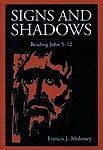
"As in the first volume of my narrative commentary on the Fourth Gospel, I am pursuing a reading of the text of the Fourth Gospel that attempts to blend traditional historical critical scholarship and the more contemporary reader-oriented approaches to a narrative text. Tracing the evolving reader is but one way of approaching a narrative text. It disassociates itself from the widespread attempts to seek unity in the putative thought of the Evangelist who is long since dead as it attempts to demonstrate unity at the level of the interplay between the author and the reader in a text whose present readership keeps it alive.
"In some ways a study of John 5-12 could be a monograph in its own right. It must be recognized, however, that the reader in 5:1 is a product of John 1-4. The title, Signs and Shadows, is drawn from a homily of Leo the Great: 'Lord, you drew all things to yourself so that all nations everywhere in their dedication to you might celebrate in a full, clear sacramental rite, what was done only in the Jewish Temple and in signs and shadows' (Sermon 8 on the Passion of the Lord). It suggests that John 5-10 presents Jesus as the perfection of Jewish liturgy and theology, and that John 11-12 points to a "lifting up" that will attract all nations."
(from the Preface)(for a complete review of this book, please see: CONTENTS:
Chapter 1: Jesus and the Sabbath: John 5:1-47
Chapter 2: Jesus and the Passover: John 6:1-71
Chapter 3: Jesus and Tabernacles, 1: John 7:1-8:59
Chapter 4: Jesus and Tabernacles, 2: John 9:1-10:21
Chapter 5: Jesus and Dedication: John 10:22-42
Chapter 6: A Resurrection That Will Lead to Death: John 11:1-54
Chapter 7: The Hour Has Come: John 11:55-12:50